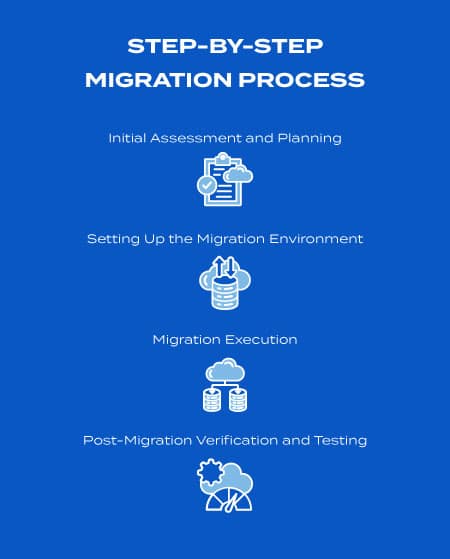In today’s data-driven world, businesses must continually adapt and evolve their IT infrastructure to stay competitive and meet growing demands. One critical aspect of this evolution is database migration, a process that involves moving data from one database to another. Whether you’re upgrading to a more advanced system, consolidating data, or transitioning to the cloud, understanding how to perform database migration correctly is essential to ensuring data integrity, minimizing downtime, and achieving operational efficiency.
This blog post will guide you through the intricate process of database migration, offering insights into what it entails and why it matters. You’ll learn about the different types of database migration, essential planning steps, execution strategies, and post-migration practices. By the end of this article, you’ll be equipped with the knowledge and tools needed to execute a successful database migration, avoiding common pitfalls and leveraging best practices to ensure a smooth transition.
We encourage you to read the entire post to gain a comprehensive understanding of database migration and how to do it right. Whether you’re a seasoned IT professional or a business leader looking to modernize your data infrastructure, this guide will provide valuable information to help you navigate the complexities of database migration confidently and effectively.
Let’s get started!
Contents
- Chapter 1: The Basics
- Chapter 2: Types of Database Migration
- Chapter 3: Planning for Database Migration
- Chapter 4: How to Perform Database Migration
- Chapter 5: Common Challenges and How to Overcome Them
- Chapter 6: Best Practices for Successful Database Migration
- Chapter 7: Case Studies and Examples
- Conclusion
Chapter 1: The Basics
In this chapter, we will explore the fundamental concepts of database migration, a critical process in the modern data-driven landscape. As we delve into the basics, you will gain a comprehensive understanding of what database migration entails and why it is essential for businesses today. We will start by defining database migration, unraveling its various dimensions, and explaining its significance. By the end of this chapter, you will be equipped with a solid foundation that will prepare you for the more intricate details and practical steps discussed in the following chapters. Prepare to embark on a journey that demystifies the complexities of database migration and highlights its pivotal role in the digital transformation of organizations.
What is Database Migration?
Database migration is the process of transferring data from one database to another. This can involve moving data between different types of databases, such as from an on-premises database to a cloud-based database, or between two different database management systems (DBMS), like from MySQL to PostgreSQL. The process is not merely about moving data; it also involves transforming data to fit the new database structure and ensuring that the migrated data maintains its integrity and usability.

At its core, database migration addresses the need to modernize IT infrastructure, enhance performance, and improve scalability. As organizations grow and evolve, their data requirements change, necessitating the migration to more robust, flexible, and efficient database solutions. This process can involve a variety of methods, including physical migration, logical migration, and cloud migration, each with its own set of tools and techniques tailored to specific scenarios and needs.
One critical aspect of database migration is data transformation. During migration, data often needs to be restructured and reformatted to align with the new database schema. This might involve converting data types, merging databases, or even redesigning the database architecture. Such transformations are essential to ensure that the data is accessible, reliable, and ready for use in the new environment.
The migration process also includes thorough testing and validation to ensure data accuracy and integrity. Before the final switchover, it’s crucial to run comprehensive tests to identify any potential issues and address them proactively. This phase helps in minimizing the risk of data loss or corruption, ensuring a smooth transition.
In essence, database migration is a multifaceted process that goes beyond simple data transfer. It involves careful planning, detailed analysis, and meticulous execution to ensure that the data is accurately and securely moved to a new environment, thereby supporting the organization’s evolving data needs and strategic goals.
Why Does Database Migration Matter in Today’s Data-Driven World?
In today’s data-driven world, database migration holds immense significance for businesses striving to stay competitive and agile. As organizations accumulate vast amounts of data, they need robust, scalable, and efficient database systems to manage and utilize this information effectively. Migrating to a more advanced database infrastructure allows businesses to leverage cutting-edge technologies that offer improved performance, enhanced security, and greater flexibility. This transition is crucial for maintaining operational efficiency and gaining actionable insights from data.
Database migration also plays a vital role in supporting digital transformation initiatives. As companies adopt cloud computing, artificial intelligence, and big data analytics, the demand for seamless data integration and accessibility increases. Migrating databases to the cloud, for instance, enables businesses to capitalize on the scalability, cost-efficiency, and remote accessibility that cloud platforms offer. This move not only enhances data management capabilities but also supports the deployment of innovative applications and services that drive business growth.
Another important aspect is the need to maintain compliance with evolving regulatory standards. Data protection regulations, such as the General Data Protection Regulation (GDPR) and the California Consumer Privacy Act (CCPA), impose stringent requirements on how data is stored, managed, and secured. Database migration allows organizations to update their data infrastructure to meet these compliance standards, thereby mitigating legal risks and protecting sensitive information.
Furthermore, database migration can significantly improve disaster recovery and business continuity plans. Modern database systems offer advanced backup and recovery solutions that minimize data loss in the event of hardware failures, cyberattacks, or natural disasters. By migrating to these systems, organizations can ensure that their critical data is safeguarded and that they can quickly resume operations after an unexpected disruption.
Ultimately, database migration is about future-proofing an organization’s data strategy. As the volume and complexity of data continue to grow, businesses need to adapt to new technologies and methodologies to stay ahead. A successful database migration not only addresses current data management challenges but also positions the organization to harness future opportunities, ensuring long-term success in an increasingly data-centric world.
Chapter 1 has laid the groundwork by explaining the essential concepts and significance of database migration. We have defined what database migration is and explored its critical role in modernizing IT infrastructure, supporting digital transformation, ensuring regulatory compliance, and enhancing disaster recovery. With a solid understanding of these basics, you are now ready to delve deeper into the various types of database migration in Chapter 2. Stay with us as we navigate through the different migration strategies, helping you choose the right approach for your organization’s needs and setting the stage for a successful migration journey.
Chapter 2: Types of Database Migration
In this chapter, we will explore the various types of database migration, each serving distinct purposes and suited for different scenarios. Understanding these types is crucial for determining the best approach for your organization’s unique needs. By the end of this chapter, you will have a comprehensive grasp of the primary migration methods, including schema migration, data migration, application migration, and database replication. We will delve into the definitions, provide real-world examples, and discuss common use cases for each type. This knowledge will equip you with the insights needed to make informed decisions and strategically plan your database migration efforts.

Database migration is not a one-size-fits-all process; it encompasses various types that cater to different aspects of moving data and applications. Each type of migration addresses specific challenges and requirements, making it essential to choose the right method for your particular situation. In this chapter, we will break down the four main types of database migration: schema migration, data migration, application migration, and database replication. By understanding the unique characteristics and applications of each type, you will be better prepared to tackle the complexities of your migration project and ensure a smooth transition to a new database environment.
Schema Migration
Schema migration involves transferring the database schema—the structure that defines the organization of data within a database—from one database to another. This process includes moving tables, indexes, constraints, and relationships that form the blueprint of the data stored in the database. Schema migration is often necessary when upgrading to a new database management system (DBMS) or when restructuring the database to improve performance and scalability.
Common use cases for schema migration include scenarios where an organization is transitioning from a legacy system to a more modern DBMS, which may have different schema requirements. For example, moving from an on-premises SQL database to a cloud-based NoSQL database necessitates significant schema changes to accommodate different data models. Additionally, schema migration is essential during mergers and acquisitions, where integrating different databases into a unified system requires aligning their structures.
Data Migration
Data migration is the process of transferring data from one storage system to another. Unlike schema migration, which focuses on the database structure, data migration deals with the actual data contained within the database. This process often involves data transformation and cleansing to ensure compatibility with the new system and to improve data quality.
Data migration is commonly used when organizations move their data to new storage systems or cloud platforms to take advantage of better performance, cost savings, or enhanced data management features. For instance, migrating data from a traditional on-premises server to a cloud-based data warehouse like Amazon Redshift or Google BigQuery allows organizations to leverage advanced analytics and big data processing capabilities. It is also crucial during system upgrades and application migrations, where data needs to be moved to support new functionalities and improve operational efficiency.
Application Migration
Application migration involves moving an application from one environment to another, which often includes migrating the underlying database that the application relies on. This type of migration is more comprehensive, as it encompasses not just the data and schema but also the application logic, middleware, and user interfaces that interact with the database.
Application migration is typically undertaken to modernize legacy applications, enhance performance, or consolidate multiple applications into a unified platform. For example, an organization might migrate its customer relationship management (CRM) application from an on-premises environment to a cloud-based service like Salesforce to take advantage of improved scalability and integration capabilities. This process ensures that the application functions seamlessly in the new environment, providing a better user experience and supporting business growth.
Database Replication
Database replication involves copying and maintaining database objects, such as tables and transactions, in multiple database systems to ensure consistency and reliability. Replication can be done in real-time or at scheduled intervals, depending on the requirements. This type of migration ensures that data is synchronized across different locations, which is essential for high availability and disaster recovery.
Common use cases for database replication include scenarios where businesses need to distribute data across various geographic locations to improve access speed and reliability. For instance, a multinational corporation might replicate its central database to regional servers to ensure that employees across different countries have fast and reliable access to critical data. Additionally, replication is crucial for disaster recovery strategies, where maintaining copies of data in separate locations ensures that a backup is available in case of hardware failures or data breaches.
This chapter
has provided an in-depth look at the different types of database migration, each tailored to address specific challenges and scenarios. From schema migration’s focus on structure to data migration’s emphasis on content and from the comprehensive approach of application migration to the reliability of database replication, understanding these types equips you with the knowledge to choose the right strategy for your migration needs. As we move to Chapter 3, we will discuss the critical planning phase of database migration, offering insights and best practices to ensure a successful transition.
Chapter 3: Planning for Database Migration
Planning is a crucial phase in the database migration process, laying the groundwork for a smooth and successful transition. This chapter focuses on the essential steps and considerations necessary for effective planning. By understanding and addressing these foundational elements, you can mitigate risks, minimize downtime, and ensure that the migration process aligns with your business objectives. After reading this chapter, you will be equipped with the knowledge to assess your migration needs, choose the appropriate strategy, and prepare a comprehensive pre-migration checklist to guide you through the process.
In the following sections, we will delve into key aspects of planning for database migration. We will start by discussing how to assess your specific needs and define the scope of the migration. Then, we will explore the different migration strategies, comparing the “big bang” approach with the “trickle” method and weighing the pros and cons of each. Finally, we will outline a pre-migration checklist that covers infrastructure preparation, data integrity measures, and essential backup procedures. This thorough planning will set the stage for a successful database migration.
Assessing Your Needs
Assessing your needs involves evaluating the necessity and scope of the migration. It starts with identifying the primary reasons for the migration, such as upgrading to a more advanced system, improving performance, or consolidating multiple databases. This evaluation helps in understanding the scale and complexity of the migration project, allowing you to allocate the necessary resources and time effectively.

Source: Made with AI.
Furthermore, this assessment should include a detailed analysis of the existing database environment, including the current data volume, the structure and schema of the data, and any potential compatibility issues with the target system. By thoroughly understanding your current setup and requirements, you can develop a clear migration plan that addresses all critical aspects and aligns with your business objectives.
Choosing the Right Migration Strategy
Choosing the right migration strategy is pivotal to the success of database migration. The two primary strategies are the “big bang” approach and the “trickle” migration. The Big Bang approach involves migrating all data and applications in one go, usually during scheduled downtime. This method is faster but carries higher risks of extended downtime and potential data loss if issues arise during the migration.
On the other hand, the trickle migration strategy involves a phased approach, where data is gradually transferred over a period while the old and new systems run concurrently. This method minimizes downtime and allows for ongoing testing and validation, reducing the risk of critical failures. However, it requires more complex management and synchronization efforts. Understanding the advantages and drawbacks of each strategy helps in making an informed decision that suits your organization’s needs and risk tolerance.
Pre-Migration Checklist
Preparing a comprehensive pre-migration checklist is essential to ensure a smooth transition. This checklist should include preparing the infrastructure, such as ensuring that the target environment is set up correctly and is capable of handling the incoming data. It should also involve a thorough testing of the new environment to identify and resolve any potential issues before the actual migration.
Ensuring data integrity and consistency is another critical aspect of the pre-migration checklist. This involves validating the data to ensure it is accurate and complete and setting up processes to maintain data consistency during the migration. Additionally, establishing robust backup procedures is crucial to protect against data loss. Regular backups should be taken, and recovery plans should be in place to restore data in case of any failures during the migration process. These steps help in mitigating risks and ensuring a successful migration.
In Chapter 3, we have highlighted the importance of meticulous planning for a successful database migration. By assessing your needs, choosing the right migration strategy, and preparing a detailed pre-migration checklist, you can significantly increase the chances of a smooth and efficient transition. As we move forward, we will delve into the practical steps of performing the database migration, providing detailed guidance and best practices to execute the plan effectively. Stay tuned to learn how to bring your migration strategy to life and overcome common challenges during the migration process.
Chapter 4: How to Perform Database Migration
In this chapter, we will delve into the practical aspects of performing a database migration. You will learn about the various tools and technologies available for database migration, the step-by-step process involved, and the importance of thorough testing and validation. By the end of this chapter, you will be equipped with the knowledge to execute a database migration confidently and effectively, ensuring a seamless transition and minimal disruption to your operations. This chapter is designed to provide you with actionable insights and detailed guidance, turning your migration plans into a successful reality.
Here, we will guide you through the essential stages of performing a database migration. We will start with an overview of popular migration tools and technologies, helping you choose the right tools for your specific needs. Following this, we will provide a detailed walkthrough of the migration process, from initial planning to post-migration verification. Finally, we will emphasize the importance of testing and validation, discussing various testing types and best practices to ensure the integrity and performance of your migrated database.
Tools and Technologies for Database Migration
When it comes to database migration, selecting the right tools and technologies is crucial for ensuring a smooth and efficient process. Among the popular migration tools are AWS Database Migration Service (DMS), Azure Database Migration Service, and Google Cloud Data Transfer Service. Each of these tools offers a range of features tailored to different migration needs and environments.
AWS Database Migration Service (DMS) is widely used for its ability to support both homogeneous and heterogeneous migrations, meaning it can handle migrations between different types of databases (e.g., Oracle to MySQL). AWS DMS provides continuous data replication with minimal downtime, making it an ideal choice for large-scale migrations. Additionally, it integrates seamlessly with other AWS services, enhancing its functionality and ease of use.
Azure Database Migration Service offers a comprehensive solution for migrating databases to the Azure platform. It supports various database types, including SQL Server, MySQL, and PostgreSQL, and provides a step-by-step migration guide to simplify the process. The service includes robust tools for assessment, schema conversion, and data migration, ensuring that the transition is smooth and that data integrity is maintained throughout the process.
Google Cloud Data Transfer Service, on the other hand, focuses on migrating data into Google Cloud, providing high-speed, secure, and scalable data transfer solutions. It supports various data sources and offers detailed logging and monitoring capabilities to ensure transparency and control during the migration.
Step-by-Step Migration Process
Performing a database migration involves several critical steps that need to be carefully planned and executed. The process begins with an initial assessment and planning phase, where the scope of the migration is defined, and a detailed migration plan is developed. This phase includes evaluating the current database environment, identifying potential challenges, and setting clear objectives for the migration.

The next step is setting up the migration environment. This involves preparing both the source and target databases, ensuring that the necessary infrastructure is in place, and configuring the migration tools. At this stage, it is essential to establish a robust backup and recovery plan to safeguard against data loss. The migration environment setup also includes configuring network settings, security parameters, and any necessary middleware to facilitate the migration.
Once the environment is set up, the actual migration execution begins. This phase includes data extraction, transformation, and loading (ETL) processes, where data is moved from the source to the target database. Depending on the migration strategy (big bang or trickle), this step might involve multiple iterations and synchronization efforts to ensure data consistency.
After the migration, post-migration verification and testing are conducted to validate that all data has been accurately transferred and that the new database is functioning correctly. This phase is crucial for identifying and resolving any issues before the system goes live.
Testing and Validation
Testing and validation are integral parts of the database migration process, ensuring that the migrated database meets all performance and functionality requirements. The importance of testing cannot be overstated, as it helps identify potential issues, validate data integrity, and confirm that the migration objectives have been met. Thorough testing minimizes the risk of data loss, downtime, and other post-migration challenges.
There are several types of testing that should be conducted during the migration process. Unit testing involves checking individual components of the database to ensure they function correctly. Integration testing focuses on verifying that different parts of the database and related applications work together seamlessly. Performance testing assesses the database’s performance under various conditions to ensure it meets the required speed, responsiveness, and scalability criteria.
Best practices for thorough testing include creating a comprehensive testing plan that covers all aspects of the migration, using automated testing tools to increase efficiency, and conducting multiple rounds of testing to identify and resolve issues. It is also essential to involve stakeholders in the testing process to ensure that the migrated database meets their needs and expectations. Documenting all test results and addressing any identified issues promptly will help ensure a successful migration and a reliable, high-performing database in the new environment.
Chapter 4 has provided a detailed guide on how to perform a database migration, covering the essential tools and technologies, step-by-step process, and the critical role of testing and validation. Armed with this knowledge, you can confidently execute your migration plan, ensuring a seamless transition and minimal disruption to your operations. As we move to Chapter 5, we will explore the common challenges encountered during database migrations and provide strategies to overcome them, helping you to navigate any obstacles and achieve a successful migration. Stay tuned to learn more about troubleshooting and problem-solving in the next phase of your migration journey.
Chapter 5: Common Challenges and How to Overcome Them
In this chapter, we will address the common challenges that organizations often face during database migration and provide strategies to overcome them. Navigating these obstacles is crucial for ensuring a successful migration process that maintains data integrity, minimizes downtime, and delivers optimal performance. By understanding and preparing for these potential issues, you can proactively manage risks and implement effective solutions. After reading this chapter, you will be equipped with the knowledge and tools to tackle the most frequent challenges in database migration, ensuring a smoother and more reliable transition.
The sections below will delve into specific challenges, providing detailed insights and practical advice on how to address each one. We will begin by discussing data loss and corruption exploring preventive measures and recovery strategies to safeguard your data. Next, we will examine downtime and performance issues, offering techniques to minimize disruptions and maintain system performance. Finally, we will cover compatibility issues, focusing on how to handle schema and data type discrepancies and adapt applications to the new database environment.
Data Loss and Corruption
Data loss and corruption are significant concerns during database migration. Preventive measures are essential to safeguard data integrity throughout the process. One key approach is to perform comprehensive data backups before initiating the migration. Regular backups create multiple restore points, ensuring that you can recover the data if anything goes wrong during the transfer. Additionally, implementing data validation checks at various stages of the migration process helps to identify and rectify any inconsistencies or errors promptly. Utilizing robust migration tools that include built-in data integrity checks can further enhance the reliability of the migration process.
Recovery strategies are equally important in managing data loss and corruption. Establishing a well-defined recovery plan is crucial for minimizing downtime and data loss. This plan should include detailed procedures for restoring data from backups, identifying and isolating corrupted data, and reapplying migration scripts if necessary. It is also beneficial to conduct regular disaster recovery drills to ensure that the recovery processes are effective and that the team is well-prepared to handle any issues that arise. Proactively testing the recovery plan can help in identifying potential weaknesses and making necessary improvements before an actual data loss incident occurs.
To mitigate the risk of data corruption, it is vital to use reliable and tested migration tools that support error handling and data validation. Additionally, maintaining an audit trail of all migration activities can help track changes and identify the source of any data corruption. This audit trail can be invaluable during troubleshooting and recovery efforts, providing a clear record of actions taken during the migration. By combining preventive measures with robust recovery strategies, organizations can significantly reduce the risk of data loss and corruption during database migration.
Downtime and Performance Issues
Minimizing downtime during database migration is crucial for maintaining business continuity and minimizing disruptions. One effective strategy is to plan the migration during periods of low activity, such as weekends or off-peak hours, to reduce the impact on users. Additionally, adopting a phased or trickle migration approach can help gradually transfer data while keeping the system operational. This method allows for continuous monitoring and adjustment, ensuring that any issues are addressed promptly without significant downtime.

Ensuring performance during and after migration involves several key steps. First, it is essential to optimize the migration process by using efficient data transfer methods and tools. Pre-migration performance testing can help identify potential bottlenecks and make necessary adjustments to the migration plan. During the migration, continuous monitoring of system performance is essential to detect and resolve issues in real-time. After the migration, thorough performance testing should be conducted to ensure that the new database environment meets the required performance standards.
In addition to these measures, maintaining clear communication with stakeholders throughout the migration process is critical. Keeping users informed about planned downtime and performance expectations can help manage their expectations and reduce frustration. Providing regular updates on the progress of the migration and addressing any performance concerns promptly can further enhance user satisfaction and confidence in the new system. By implementing these strategies, organizations can minimize downtime and ensure optimal performance during and after the database migration.
Compatibility Issues
Handling schema and data type discrepancies is a common challenge during database migration. Differences in database structures and data types between the source and target systems can lead to compatibility issues. To address these discrepancies, it is essential to conduct a thorough assessment of both the source and target databases before the migration. This assessment should include identifying and documenting all schema differences, data type mismatches, and any other compatibility concerns. Once these issues are identified, appropriate transformation rules and mapping strategies can be developed to ensure that data is accurately migrated and compatible with the new database environment.
Adapting applications to the new database environment is another critical aspect of managing compatibility issues. Applications that interact with the database may require modifications to function correctly with the new database system. This process involves updating connection strings, adjusting query syntax, and ensuring that any application-specific logic that depends on the old database structure is updated to align with the new schema. Comprehensive testing of applications in a staging environment is essential to identify and resolve any compatibility issues before going live.
Furthermore, leveraging database migration tools that support automated schema conversion and data type mapping can simplify the process and reduce the risk of errors. These tools often include features for detecting and resolving compatibility issues, providing a smoother transition. Additionally, engaging database experts or consulting with tool providers can offer valuable insights and assistance in handling complex compatibility challenges. By proactively addressing schema and data type discrepancies and ensuring that applications are adapted to the new environment, organizations can overcome compatibility issues and achieve a successful database migration.
In Chapter 5, we have explored the common challenges faced during database migration and provided practical strategies to overcome them. From preventing data loss and corruption to minimizing downtime and addressing compatibility issues, these insights equip you with the knowledge to tackle the most frequent obstacles in the migration process. Next, you will learn about the best practices for ensuring a successful database migration, further enhancing your ability to execute a smooth and efficient transition. Stay tuned to discover proven strategies and expert tips that will guide you through the complexities of database migration and help you achieve your goals.
Chapter 6: Best Practices for Successful Database Migration
In this chapter, we will delve into the best practices that can ensure a successful database migration. Effective migration requires more than just moving data from one place to another; it involves meticulous planning, maintaining data quality, and ongoing monitoring and maintenance. By following these best practices, you can mitigate risks, ensure data integrity, and optimize performance throughout the migration process. After reading this chapter, you will be equipped with practical strategies and insights to execute a seamless and efficient database migration, laying a strong foundation for your organization’s data management needs.
Thorough Planning and Documentation
Thorough planning and documentation are foundational to a successful database migration. A detailed migration plan acts as a roadmap, guiding every step of the process from initial assessment to post-migration activities. This plan should outline the scope of the migration, timelines, resource allocation, risk management strategies, and detailed steps for each phase of the migration. By having a clear plan, you can anticipate potential challenges, allocate resources effectively, and ensure that all stakeholders are aligned with the migration objectives.
Keeping comprehensive documentation throughout the migration process is equally crucial. Documentation serves multiple purposes: it provides a record of the decisions made and actions taken, facilitates communication among team members, and acts as a reference for troubleshooting any issues that arise. Key documents to maintain include the migration plan, risk assessments, data mapping, testing protocols, and post-migration reports. Comprehensive documentation ensures transparency and accountability, making it easier to track progress and address any unforeseen issues promptly.
Moreover, detailed documentation can significantly aid in knowledge transfer and future migrations. When new team members join the project or when similar migrations are planned in the future, well-maintained records provide valuable insights and lessons learned. This not only enhances the efficiency of the current migration but also builds a repository of best practices that can be leveraged across the organization for continuous improvement.
Ensuring Data Quality and Integrity
Maintaining data quality and integrity is paramount during a database migration. Techniques for ensuring data quality include data profiling, cleansing, and transformation. Data profiling involves analyzing the data to understand its structure, relationships, and content. This helps identify inconsistencies, duplicates, and errors that need to be addressed before migration. Data cleansing is the process of correcting these issues, ensuring that the data is accurate, complete, and consistent. Data transformation involves converting data into the appropriate format required by the target database, ensuring compatibility and usability.

Regular audits and checks are essential for maintaining data integrity throughout the migration process. Audits should be conducted at various stages of the migration to verify that the data has been accurately and completely transferred. This includes running data validation checks to compare source and target data, ensuring that no data is lost or corrupted during the migration. Additionally, implementing automated tools for data validation can enhance efficiency and accuracy, reducing the risk of human error.
Post-migration, it is crucial to continue monitoring data quality and integrity through regular checks and audits. This ongoing vigilance helps quickly identify and rectify any issues that might arise, ensuring that the data remains reliable and trustworthy. Establishing data governance policies and procedures can further support data quality maintenance, providing a structured framework for managing and protecting data assets in the long term.
Post-Migration Monitoring and Maintenance
Continuous monitoring and routine maintenance are critical to the success of a database migration. Continuous monitoring strategies involve setting up automated alerts and dashboards to track the performance and health of the database in real-time. This enables the immediate detection of anomalies, performance bottlenecks, or any other issues that could impact the database’s functionality. Proactive monitoring ensures that problems are identified and resolved before they can affect users, maintaining the system’s reliability and performance.
Routine maintenance practices are essential for the long-term health and efficiency of the database. This includes regularly scheduled tasks such as database tuning, indexing, and updating database statistics. Maintenance activities help in optimizing the performance of the database, ensuring that it operates efficiently under varying workloads. Additionally, routine maintenance includes periodic backups, which are crucial for data protection and recovery in case of any failures or data loss incidents.
Furthermore, it is important to conduct regular reviews and updates of the database environment to adapt to changing business requirements and technological advancements. This involves updating security protocols, implementing new features or updates provided by the database vendor, and scaling the database infrastructure as needed. By incorporating continuous monitoring and routine maintenance into your database management practices, you can ensure that the database remains robust, secure, and capable of meeting the evolving needs of the organization.
This chapter
has highlighted some of the top best practices essential for a successful database migration. From thorough planning and comprehensive documentation to ensuring data quality and ongoing post-migration monitoring, these practices provide a solid foundation for a smooth and effective transition. Next, we will explore real-world case studies and examples that illustrate these principles in action, providing practical insights and lessons learned from successful database migrations. Stay tuned to discover how these strategies have been applied in various scenarios and how they can be tailored to meet your specific needs.
Chapter 7: Case Studies and Examples
In this chapter, we will delve into real-world case studies and examples that highlight the complexities and nuances of database migration. By examining both success stories and lessons learned from failures, you will gain a deeper understanding of the practical challenges and solutions involved in migration projects. These case studies provide valuable insights into best practices, common pitfalls, and innovative approaches, helping you apply these lessons to your own database migration efforts. After reading this chapter, you will be better equipped to navigate the intricacies of migration with confidence and foresight.
Understanding the practical aspects of database migration can be greatly enhanced by studying real-world examples. In this chapter, we will explore both successful migrations and those that faced significant challenges. These case studies will provide a comprehensive view of what it takes to execute a database migration, highlighting the factors that contribute to success and the common pitfalls to avoid. By learning from these real-world scenarios, you will be able to apply proven strategies and avoid common mistakes in your own database migration projects. Let’s begin by looking at some success stories and the lessons they offer, followed by an analysis of migrations that did not go as planned and the insights we can draw from them.
Success Stories
One notable example of a successful database migration is the case of Netflix. When Netflix decided to migrate its databases to the cloud, they chose Amazon Web Services (AWS) as their cloud provider. This migration allowed Netflix to scale its operations globally, handle significant increases in data traffic, and improve the overall user experience. Key to their success was thorough planning and phased implementation. Netflix began with non-critical workloads, gradually moving to more critical operations as they refined their migration strategy. This approach minimized risks and allowed for continuous testing and optimization.
Another success story is that of Spotify, which migrated its databases from on-premises servers to Google Cloud Platform (GCP). Spotify faced the challenge of ensuring uninterrupted service to millions of users while migrating large volumes of data. They employed a dual-write strategy, where data was simultaneously written to both the old and new databases during the transition period. This ensured data consistency and allowed Spotify to verify the integrity of the new database without affecting user experience. The successful migration resulted in improved scalability, performance, and cost efficiency.
Lessons learned from these successful migrations highlight the importance of meticulous planning, phased execution, and robust testing. Both Netflix and Spotify demonstrated the value of starting with non-critical workloads and using strategies like dual writes to ensure data integrity. Additionally, choosing the right cloud provider and leveraging their tools and expertise played a significant role in the smooth execution of these migrations. These cases underscore the importance of a well-thought-out migration plan and the flexibility to adapt strategies as needed.
Lessons from Failures
Not all database migrations go smoothly, and there are valuable lessons to be learned from those that encounter significant challenges. One such example is the migration of the United States Air Force’s logistics system to a new database platform. The project faced numerous issues, including underestimated data complexity, insufficient testing, and lack of stakeholder communication. These challenges led to extended downtime, data integrity issues, and a final solution that failed to meet the initial performance expectations. The project highlighted the critical need for comprehensive data analysis and robust testing before and during the migration process.

Another example is the database migration attempt by a major financial institution. They aimed to transition from a legacy system to a modern database infrastructure. However, the project was plagued by data corruption issues due to incompatible data formats and poor schema mapping. Additionally, the lack of a detailed backup and recovery plan led to significant data loss when problems arose. This migration faced prolonged downtime, affecting the institution’s operations and customer trust. The failure underscored the importance of detailed planning, compatibility checks, and a strong focus on data integrity and recovery strategies.
Analysis of these failures reveals several common pitfalls to avoid. First, underestimating the complexity of the data and the migration process can lead to significant issues. Comprehensive data profiling and analysis are essential to identify potential challenges early on. Second, insufficient testing can result in undetected errors that cause major disruptions. Implementing thorough testing phases, including pilot migrations, can mitigate this risk. Finally, a robust backup and recovery plan is crucial to handle any unforeseen issues during the migration. These cases illustrate the importance of detailed preparation, continuous testing, and effective risk management to ensure a successful database migration.
Chapter 7 has provided a detailed examination of both successful and challenging database migrations, offering valuable insights and lessons. From the success stories of Netflix and Spotify to the cautionary tales of the United States Air Force and a major financial institution, these case studies underscore the critical factors that can determine the outcome of a migration project. Next, we will summarize the key points and offer some final recommendations. Keep these real-world examples in mind to guide your own database migration endeavors. Understanding both the successes and failures will help you navigate the complexities of migration with greater confidence and preparedness.
Conclusion
In this comprehensive guide to database migration, we have explored the critical aspects of migrating databases, from understanding the basics to examining real-world case studies. You have learned about the different types of database migration, including schema migration, data migration, application migration, and database replication. We delved into the essential planning steps, highlighted the importance of thorough documentation, and discussed techniques for ensuring data quality and integrity. Additionally, we covered the execution of the migration process, emphasized the necessity of post-migration monitoring, and shared valuable lessons from both successful migrations and those that encountered challenges.
Embarking on a database migration can be a daunting task, but with careful planning, detailed documentation, and adherence to best practices, you can navigate this complex process successfully. Remember to assess your specific needs, choose the right migration strategy, and prepare a comprehensive pre-migration checklist. Ensure that you maintain data quality and integrity throughout the process and conduct thorough testing and validation. Continuous monitoring and routine maintenance post-migration will help sustain the health and performance of your new database environment.
We hope this guide has provided you with the knowledge and confidence to undertake your database migration journey. If you have any questions or need further clarification, please feel free to leave a comment below. We would love to hear about your experiences and any additional tips you might have. Don’t forget to share this post with others who might find it useful, and check out our other articles for more insights and guidance on database management and IT infrastructure. Thank you for reading, and best of luck with your database migration project!
